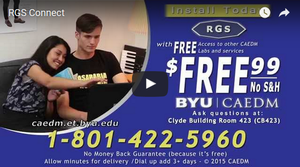In CAEDM we refer to ZConnect as the software client for connection to ZCentral, which refers to the hardware/workstation
RGS was rebranded as ZCentral Remote Boost by HP in 2021
HP ZCentral Remote Boost (formerly known as HP Remote Graphics Software or HP RGS) is a client-server remote desktop software produced by Hewlett Packard specifically designed for use with graphics-intensive applications. It is similar in function to Citrix, remote desktop, or VNC, but is specifically designed to handle graphic intensive applications such as 3D modeling.
Contents
How CAEDM uses ZCentral
The college is heavily invested in ZCentral technology, allowing anyone with a CAEDM account to use graphics-intensive applications from anywhere with a robust internet connection. Since a ZCentral workstation displays everything going on graphically, it can be network intensive. We recommend using a wired internet connection for best results. CAEDM supports Windows and Linux clients connecting to both Windows and Linux ZCentral workstations.
Each user logged into a ZConnect session uses one physical ZCentral workstation in one of our server rooms. Each workstation has multiple processors and gigabytes of memory, making high-end CAD and graphics work possible. You will not find all CAEDM software on ZConnect because not all software requires multiple processors and high-end graphics. Less resource intensive applications are instead installed on Citrix, which allows many users to share the resources of one physical server.
Download ZConnect
ZConnect Client downloads are available on the CAEDM Downloads page. The ZConnect Client is available for Mac, Windows 10, and Red Hat or Debian based distributions of Linux.
Using ZConnect
Run the ZConnect shortcut from your Start menu. Login to the ZConnect client using your CAEDM credentials. From here you may choose to connect to a Windows or Linux machine, from both on or off campus. You will then automatically be directed to a free machine of the type chosen.
Once logged in, you will see a full desktop, including a Start menu, of a remote workstation with all the graphics-intensive software installed. When finished, please use the "logoff" button on the task bar, or select "logoff" from the Start menu. Please do not just close the ZConnect session window with the "red X" in the top right corner. This will not log you out, but will "disconnect" your session. Disconnected sessions stay available for a number of minutes before you are forcibly logged off.
To switch between full screen mode, or to toggle an advanced options toolbar at the top of the page, use the following key sequence:
<shift(hold)><space depress><space release>+<h>
(If this toolbar was accidentally accessed, simply use the sequence above to toggle it off.)
ZConnect Extended Use Computers
Using a ZConnect workstation is just like using a standard CAEDM Lab machine in that you will be logged off after 30 minutes of inactivity. For most purposes, you will be actively involved with your session; however, there may be times you simply need the computing power and do not to be active in the session. CAEDM has a few machines that are set just for this purpose. You can log into those computers for an extended, non-interactive session. As there are a limited number of these computers, permission is granted on a week-long basis at this page: [Extended Use RGS]
Printing in a ZConnect Session
Printing from within a ZConnect session from a ZCentral workstation is a great resource, but it is slightly limited. From any computer ZConnect has the capability to print to a CAEDM printer, but it cannot print to local printers. The advantage of using a ZCentral workstation is the processing power, for this reason ZConnect does not provide Microsoft Office or other programs requiring lower processing power, rather, it provides CAD programs and other programs that require high end processing power.
Accessing files in a ZConnect Session
File access is a slightly limited from a ZConnect session. The user's personal J Drive will automatically be mapped and USB connections are automatically detected, but ZConnect will not automatically connect to files on the user's local machine. The best way to access personal files in a ZCentral Session is to map the J Drive on your local machine and copy the desired files to the J Drive, or to put those files onto a flash drive, as USB support is automatic.
Examples of Software on ZCentral Workstations
| Windows-based Applications | Linux-based Applications | ||
|---|---|---|---|
| CAD Programs | Altair HyperWorks, Ansys, AutoCAD, AutoCAD Civil 3D, CODE, Fluent, LSDYNA, Marc Mentat, MD R2 Adams, QT4, SolidWorks | Altair Hyperworks, Ansys, Cadence, Ensight, Fluent, iSight FD, LSDYNA, OptdesX, StarCCM+ | |
| Math | MathCAD, Maple, Mathematica, MatLab | MatLab, Maple, Mathematica | |
| Graphics | Gimp | ||
| Note: | |||
Troubleshooting
- During installation, if you receive an error stating "Failed to create process default activation context," you will need to install the .NET framework from Microsoft.
- BYU Guest Wireless is not supported. Please connect using a wired connection or Eduroam.
- If you are using ZConnect and the remote workstation becomes unresponsive, you really have little choice but to close the window to the ZConnect session. Closing the window of an ZConnect session does not log you out. Instead, it "disconnects" the user from the session. "Disconnecting" is useful, for example, if you have connected via wireless and you lose signal. ZConnect assumes that you want to come back to your session, and it holds that workstation for you for about a half-hour or so. Normally this would be a wonderful feature, but if you've locked up the workstation, every time you connect back to ZConnect you will receive the same hung workstation that is unresponsive. To fix this, you must contact an administrator.
Advanced Options
- On-screen collaboration is possible with multiple users. Click here for instructions.




